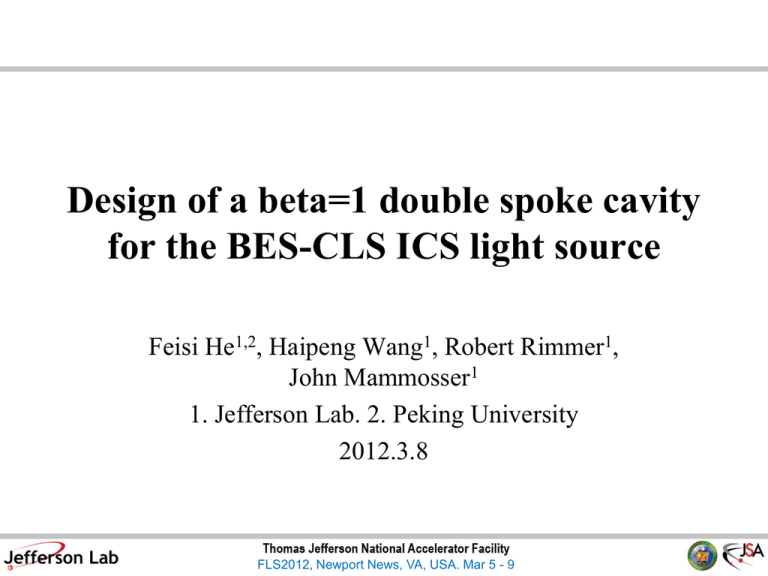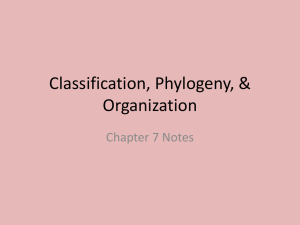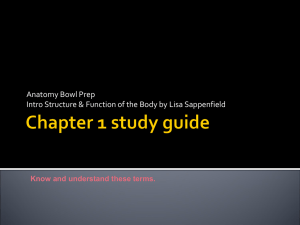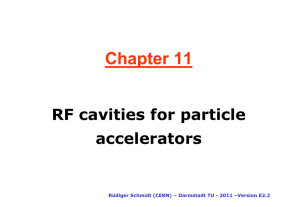Design of a beta1 double spoke cavity for the BES
advertisement

Design of a beta=1 double spoke cavity for the BES-CLS ICS light source Feisi He1,2, Haipeng Wang1, Robert Rimmer1, John Mammosser1 1. Jefferson Lab. 2. Peking University 2012.3.8 FLS2012, Newport News, VA, USA. Mar 5 - 9 Requirement to the spoke caivty[1,2] • CW Linac at 4 K for 1 mA electron, 4 MeV in, 22 MeV out (20MeV minimum). Linac length <= 4m • 2 double-spoke cavities at 352MHz with β0=1 in one cryomodule • Aperture diameter = 50 mm • Specification: – Vacc/cavity = 9 MV, Ep < 30 MV/m, Bp < 80 mT – G*R/Q as high as possible to reduce dynamic heat load – Ep/Vacc < 3.33 [m-1], Bp/Vacc < 8.89 [mT/(MV)] FLS2012, Newport News, VA, USA. Mar 5 - 9 BES-CLS cavity design overview • • • • Double spoke cavity at 352 MHz, with optimum beta of 1 Cavity length = 1241 mm Cavity diameter = 601 mm At Vacc = 9 MV, Ep = 29.8 MV/m, Bp = 52.4 mT FLS2012, Newport News, VA, USA. Mar 5 - 9 EM properties of baseline (1) • Tricks to get higher G*R/Q: – C↓; L↑; B field broad distributed – – – – L L C L C Longer and thinner spoke central part Smaller end-cone radius Larger spoke base in beam transverse direction Make field stronger in the end-gap (by making the re-entrant part deeper) • It is also easy to reduce Ep on the cost of a little bit heat load FLS2012, Newport News, VA, USA. Mar 5 - 9 L C EM properties of baseline(2) JLab prototype Aperture diameter[mm] 50 Lcavity (end-to-end) [mm] 1241 Cavity diameter [mm] 601.1 Ep/Ea 4.23 Bp/Ea [mT/(MV/m)] 7.43 Geometry factor [Ω] 191.4 Ra/Q [Ω] 727.4 Ra*Rs (=G*Ra/Q) [Ω2] 1.392 x 105 Va@Ep30MV/m [MV] 9.06 Q0 at 4.5 K (Rbcs=48nΩ, and assume Rres=20nΩ) 2.8 x 109 Power loss at Va=9MV (Rs=68nΩ) [W] 39.6 • • Leff = 1.5*β0*λ = 1276.8 [mm]; Va = V0*TTF(β0); Ea = Va/Leff = 6.6 MV/m at Va of 8.4 MV FLS2012, Newport News, VA, USA. Mar 5 - 9 MP analysis of baseline design 2: 1-2.6 MV 1: 0.7-2.5 MV 6: 7.6-9 MV 5: 6.19 MV 4: 0.65-4.5 MV Zone 1 Walking MP 2nd order Walking MP trapped 3: 1.33.8 MV Unstable walking MP Zone 2 Zone 3 & 4 Walking MP Walking MP st 2nd order FLS2012, Newport News, VA, USA. Mar 5 1 - 9 order Zone 5 & 6 Two points 1st order Prediction of MP level • • • Above 6 MV is soft barrier 0.65 – 4.5 MV is wide barrier of walking MP. Experiment on prototype is needed to indentify whether it is hard to process. Besides, some levels are especially dangerous: 1. 0.8 MV in zone 1, particles survive for > 150 RF periods with ~200 eV (6th order) 2. 1-1.2 MV in zone 2, particles survive for > 150 RF periods with 50~250 eV (3rd order) 3. 0.65-1.3 MV in zone4, stable one point MP (trapped) with 50~120 eV (3rd order) • So, 0.6-1.3 MV might be strong MP barrier Plasma cleaning may be used to process away the MP 2: 1-2.6 MV 1: 0.7-2.5 MV 6: 7.6-9 MV 5: 6.19 MV Surviving MP after 20 RF periods 3: 1.33.8 MV 4: 0.65-4.5 MV FLS2012, Newport News, VA, USA. Mar 5 - 9 Field flatness is not the reason for wide walking MP barrier E field in end cell 36% stronger than in middle cell Flat E field 4: 1.3-4.4 MV 4: 1.4-5.3 MV 1 5: 3.8-6.5 MV 3: 1-3.4 MV 2: 0.7-1.8 MV 1: 0.7-2.2 MV 5: 4.4-7 MV 6: >8 MV 3 4 3: 1.8-4.4 MV 2: 0.8-1.8 MV 1: 0.8-1.8 MV 2 FLS2012, Newport News, VA, USA. Mar 5 - 9 Increase the blending radius • • 1: 1.4-1.8 MV 2: ~1.4 MV 3: 1.8-4.6 MV FLS2012, Newport News, VA, USA. Mar 5 - 9 Our experience on a β=0.5 cavity for ESS shows that, rounder edge may help to reduce the impact energy of the 2 points, 1st order MP. Initial result is promising: it is free of stable MP in dangerous impact energy range with large blending radius Power coupling to the cavity • Beam: 1 mA, 9 MV. • With frequency fluctuation δf, Qe may be as low as 7 *106, depending on level of micro-phonics • For VTA test, Qe may be 3 *109, and through the beam pipe Lante [mm] Dport [mm] Impendance [Ω] Qe -5 75.743 50 9.26E+06 0 75.743 50 5.45E+06 0 114.80 75 4.60E+06 δf = 20 Hz δf = 15 Hz δf = 10 Hz δf = 5 Hz δf = 0 -10 19.89 50 3.96E+10 FLS2012, Newport News, VA, USA. Mar 5 - 9 Effect of ports on frequency • Omega3p simulation result: – Port at coupling port position: -40 kHz/port – Port at end plane: -20 kHz/port (perturbation method 20 kHz/port) • Perturbation method[3] for circular hole is: – Port at coupling port position: -42 kHz/port – Port at end plane: -20 kHz/port Lport [mm] SNS-type End plate 50 70 50 70 E at port at 9MV [MV/m] B at port at 9MV [mT] 1.7 40 6.4 54 B at flange at 9MV [mT] 3.8 1.4 1.5 0.3 FLS2012, Newport News, VA, USA. Mar 5 - 9 Effect of etching on frequency • Perturbation method for uniform surface removal: Etching depth [μm] 10 50 100 150 200 df/f -3.02E-05 -1.51E-04 -3.02E-04 -4.53E-04 -6.04E-04 df [kHz] -10.6 ± 0.4 -53 ± 2 -106 ± 4 -160 ± 5 -213 ± 7 – Define dL>0 for moving towards inside the cavity – a = 3.0 [m-1] for the spoke cavity (by HFSS) H field dominates – ai can be seen as the surface local frequency sensitivity, and is a reference for tuning and stiffening ring design • By offsetting surface in omega3p gives -152 kHz at 150 μm FLS2012, Newport News, VA, USA. Mar 5 - 9 Estimation of frequency tuning before welding • Control the diameter of the cavity is important • Possible to tune the frequency in the fabrication process by cutting the length of acceleration gap Compare with sensitivity of cavity can diameter: ΔD 1 [mm] ~ Δf 600 [kHz] FLS2012, Newport News, VA, USA. Mar 5 - 9 Initial frequency recipe • Prototype is needed to learn the frequency recipe for exact frequency control FLS2012, Newport News, VA, USA. Mar 5 - 9 Mechanical analysis is in progress • Methods to reduce stress on cavity 1. Switch spoke shape from race-track to elliptical 2. Increase blending radius 3. Stiff supporters may be needed for VTA test • MP analysis is promising: no stable MP at all • Lots of work still needed Ep at Va=9 Bp at Va=9 MV MV [mT] [MV/m] G [Ω] Ra/Q [Ω] G*R/Q [Ω2] Original 29.8 52.4 191.4 727.4 1.392x105 Modified 31.7 49.3 196.7 745.5 1.467x105 FLS2012, Newport News, VA, USA. Mar 5 - 9 Single spoke version for prototyping • Keep all the geometries the same as double spoke model (diameter, gap length, end cones, spoke, blendings). • Cavity length = 849 mm • Cavity diameter = 601.1 mm Lcavity [mm] Code Frequency [MHz] β0 G [Ω] R/Q [Ω] G*R/Q [Ω^2] Ep/(Va/Lca) Bp/(Va/Lca) [mT/(MV/m)] 849 CST 352.14 1 199 524 1.04E+05 3.48 6.36 FLS2012, Newport News, VA, USA. Mar 5 - 9 MP of the single spoke version • An initial study was done for single spoke with 849 mm length • The two types of MP, walking and stable two points, also exist in the single spoke, and the barrier levels looks pretty like the case in double spoke. Though, it has stronger stable MP than the double spoke in high field level. FLS2012, Newport News, VA, USA. Mar 5 - 9 Cost estimation of linac: assumptions • Capital: – 4.4K Cryo-plant of 400W with $5M (including injector); $8M if 2K cryo-plant – RF power supply and distribution of $60 / W – Cryomodule: $200k – Cavity: Nb weight based plus frequency based, $270k/Spoke cavity • Capital of alternative options: – Superconducting elliptical cavity, $2k/kg + end group $30k*1.3/f0[GHz], that is $90k for 1.3G 9cell cavity – Normal conducting standing wave cavity, $10M for 1MW RF power supply and distribution, $50k/cavity FLS2012, Newport News, VA, USA. Mar 5 - 9 Cost estimation of linac: assumptions (2) • Operational: – Working 8 hours/day, 5 days/week, 52 weeks/year – LHe static loss is continuous, where part proportional to number of cavities, and part proportional to 1/f0 – 900W/1W cooling efficiency at 4K, 3400W/1W at 2K[4] – 80W on LN shielding (300 liters LN/week), and 10₵/L – 20nΩ residual resistance to estimate dynamic heat load – 50% efficiency of RF power supply – 7₵ / kWh electric power FLS2012, Newport News, VA, USA. Mar 5 - 9 Linca cost comparison • By fitting linac in 4 m length and minimizing cryogenic heat load, the cost of superconducting and normal conducting elliptical cavities are compared to the spoke: 1. 2K operation is more expensive in all cases, since static heat load plays important role, and cooling efficiency drops 2. 704 MHz SC elliptical cavities cost a little more to operate due to higher surface resistance; 352MHz elliptical cavities are competitive in performance but bigger in diameter. 3. NC linac is longer than 10 m with dynamic loss less than 1MW 4. Capital cost dominates in all cases • Note: rough estimation; • Working in progress, not conclusive FLS2012, Newport News, VA, USA. Mar 5 - 9 Linac cost comparison (2) • Note: – LEPII cavity is only for reference, since their dynamic loss per cavity is too high for this application – Man power for operation is not included. – At JLab consumed LHe and LN is ~0.4*cryo-system electric power cost[4] – Rough estimation; working in progress, not conclusive FLS2012, Newport News, VA, USA. Mar 5 - 9 Acknowledgements • I would like to thank Shirley Yang, Gary Cheng, James Henry, Mircea Stirbet at Jlab, and William Graves at MIT for their help Thank you for your attention FLS2012, Newport News, VA, USA. Mar 5 - 9 Below are supporting materials FLS2012, Newport News, VA, USA. Mar 5 - 9 Linac comparison Name ID LEPII Nb-Cu D50_352 SC D170_352 SC D50_704 SC D70_704 SC BES-ICS double spoke Name ID D50_704 NC D50_352 NC Freque ncy MHz 352.2 352.0 352.2 704.0 704.0 352.2 Frequ ency MHz 704.0 352.0 SC cavities at 4.5K Cavity Linac Dynam Dynamic Cavity Vacc Ep on Electric Electric Estimated Peak Equat cell weight Cavity length ic loss loss of Capital Peak LHe Iris D active per operatio power power static heat electric or D no. wall no. (+0.5 m per full 21 cost heat load length cavity n cost cost load power 3mm * Nca) cavity MV mm mm kg mm MV MV/m m W W M$ $/week M$/20yrs W W kW 241 753 4 132 1702 18.0 1 24.3 2.2 214.3 214.3 7.8 1004 1.05 31 246 257 50 709 1 33 426 4.5 4 26.7 3.7 23.7 94.9 8.3 830 0.87 43 138 160 170 730 3 99 1277 9.0 2 16.5 3.6 42.8 85.5 8.2 721 0.75 35 121 145 50 355 1 8 213 3.6 5 40.7 3.6 52.1 260.4 8.0 1144 1.19 34 294 301 70 355 3 25 639 6.0 3 22.1 3.4 53.6 160.9 7.9 809 0.84 26 187 204 50 599 3 111 1277 9.0 2 28.2 3.6 39.7 79.3 8.3 706 0.74 35 115 139 Normal conducting elliptical cavity (standing wave, CW) with dynamic loss <= 1 MW of full 21 MV Linac Dynam Dynamic Cavity Vacc Ep on Electric Peak Equat cell Cavity length ic loss loss of Capital Operatio Iris D active per operatio power electric or D no. no. (+0.3m* per full 21 cost nal cost length cavity n cost power Nca) cavity MV mm mm mm MV MV/m m kW kW M$ $/week M$/20yrs kW 50 355 1 213 3.0 17 12.0 10.4 58.4 993.1 11.0 5662 5.906 2022 50 709 1 426 4.5 11 18.5 9.1 89.8 987.3 10.7 5629 5.871 2011 Assumptions: Linac length <= 4m; $2k/kg and additional $30k*1.3/f0[GHz] (end-group) per cavity for elliptical Nb cavity (plus coupler and tuner), that is $90k for 1.3G 9cell cavity; $270k/cavity for spoke cavity; 1/5 per weight price and $20 for Nb coated Cu cavity; $50k per copper cavity; $60 / W for buying small scale RF power supply, $10 / W for large scale (including load, circulator, power supply and so on); $1M for 4K cryogenic system of <100W, $5M for 400W; $8M for 2K cryogenic system; 200k for the overall one cryomodule; 7₵ / kWh electric power; 50% efficiency of RF power supply; 900W input power per 1W cooling capacity at 4K, 3400W at 2K; 20nΩ residual resistance for SC cavities; working 8 hours per day, 5days per week, 52 weeks per year; part of static loss proportional to number of cavity, and part proportional to 1/f0, according to SNS's data; 80W on LN shielding, which is 300 liters LN/week, and 10₵/liter price FLS2012, Newport News, VA, USA. Mar 5 - 9 Cavity comparison Cavity Cavity Frequenc β=v/ Iris Equato Equat cell weight R/Q / Iris r/λ active y c D r R/λ or D no. wall3m length length m Name ID MHz mm mm kg mm Ω/m G W Max Max R/Q*G / Epeak Bpeak N2/(βkcc Rs@4. P/(Vacc^ heat Rs@4. P/(Vacc^ heat kcc cavity /Eacc /Eacc ) 2K 2)@4.2K flux/Va 5K 2)@4.5K flux/Va ^2 ^2 mW/cm 2 [W / mT/(M W/(MV^2 mW/cm^ W/(MV^ % nΩ nΩ ^2/MV^ Cav] V/m) ) 2/MV^2 2) 2 LEPII Nb-Cu 352.2 1 0.142 241 0.442 753 4 132 1702 273 286 1.33E+05 2.30 3.90 1.76 D50_352 SC 352 1 0.029 0.416 709 1 33 426 512 267 5.83E+04 2.52 3.30 D170_352 SC 352.2 1 0.100 170 0.429 730 3 99 1277 358 283 1.29E+05 2.34 3.86 0.64 D50_704 SC 704 1 0.059 50 0.417 355 1 8 213 933 267 5.30E+04 2.41 D70_704 SC 704 1 0.082 70 0.416 355 3 25 639 796 D90_704 SC 704 1 0.106 90 0.415 353 5 41 1065 BES-ICS double spoke 352.2 1 0.029 50 0.352 599 3 111 1277 50 909 79 0.59 0.0131 88 0.66 0.0146 59 1.01 0.1122 68 1.17 0.1297 1406 59 0.46 0.0171 68 0.53 0.0198 3.46 0.01 7436 176 3.32 1.4728 213 4.02 1.7803 281 1.43E+05 2.35 3.55 0.34 2623 176 1.23 0.1723 213 1.49 0.2082 713 283 2.15E+05 2.59 3.74 0.89 2802 176 0.82 0.0690 213 0.99 0.0834 572 191 1.39E+05 4.39 6.66 59 0.42 0.0509 68 0.49 0.0588 Max Rs P/(Vacc^ heat copper 2) flux/Va^ 2 mΩ D50_704 NC 704 1 0.059 50 0.417 355 1 213 933 267 5.30E+04 2.41 3.46 0.01 D50_352 NC 352 1 0.029 50 0.416 709 1 426 512 267 5.83E+04 2.52 3.30 • Assume 20 nΩ Rres for SC cavities FLS2012, Newport News, VA, USA. Mar 5 - 9 7436 kW/(MV^ W/cm^2/ 2) MV^2 2.8 52 23.0877 2.0 34 3.7104 LEPII cavity performance[5,6] • At 6MV/m and 4.5K, Rs of Nb-Cu cavity ~ 88nΩ, Nb(RRR40) ~ 140nΩ. Rbcs ~ 50 nΩ • Strong Q drop; no high baking and HPR FLS2012, Newport News, VA, USA. Mar 5 - 9 MP of 352 MHz elliptical cavity • Diris = 170mm, 0.56 MHz between 2π/3 and π mode • Two points, 1st order stable MP at equator zone, with impact energy < 35 eV, at energy gain > 7.8 MV • It should be easy to process away, if ever occurs FLS2012, Newport News, VA, USA. Mar 5 - 9 Is Rres 20 nΩ reasonable for spoke?[7-15] • Many spoke cavities are w/o FE or MP at Bp~50mT • As low as <10 nΩ Rres at low field is common • Worst estimation of Rres may be 30 nΩ FLS2012, Newport News, VA, USA. Mar 5 - 9 Diameter comparison • There is a trend of increased diameter with β, since capacitance in the gaps is reduced, so inductance has to be larger to tune frequency back. FLS2012, Newport News, VA, USA. Mar 5 - 9 Diameter and dynamic load comparison • Increasing G*R/Q at the cost of diameter is the right direction to optimize a spoke cavity FLS2012, Newport News, VA, USA. Mar 5 - 9 Cryo-system efficiency[4] FLS2012, Newport News, VA, USA. Mar 5 - 9 Cavity geometry (all in mm) Dbeamp Distance of beam pipe edge to central plane 620.5 Dspokc Distance of spoke central edge to central plane 100.0 Hconeb Height of beampipe cone 73.0 Lend_e Lirisi Lspok Cavity end to end distance Cavity iris to iris distance Spoke to spoke distance 1241.0 1095.0 392.0 Rbeama Radius of beam aperture 25.0 Rbeamp Radius of beam pipe 25.0 Rblenba Radius of beam aperture blending 10.0 Rblenbp Radius of beam pipe blending 10.0 Rbleno Radius of all other blending 35.0 Rblens Radius of spoke blending 20.0 Rconebb Radius of beampipe cone base 160.0 Rconebt Rout Rspokbl Radius of beampipe cone top Radius of outer cylinder Longitudinal radius of spoke base 60.0 300.55 115.0 Rspokbt Transverse radius of spoke base 370.0 Rspokcl Longitudinal radius of spoke center 54.0 Rspokct Transverse radius of spoke center 69.0 Wspokb Width of the spoke base race-track 260.0 Wspokc Width of the spoke center race-track 38.0 Illustration of possible way to fabricate the cavity, based on Larry’s plan FLS2012, Newport News, VA, USA. Mar 5 - 9 Coupling port and service port Lante [mm] Rante [mm] Lport [mm] Rport [mm] Dport [mm] Rblenp [mm] Qe -20 10.85 50 25 400 15 2.08E+09 B on flange at 8.4MV [mT] 0.76 0 10.85 50 25 400 15 6.70E+07 0.77 0 10.85 70 25 370 15 2.13E+07 0.16 3 10.85 50 25 370 15 1.39E+07 0.70 -20 10.85 50 25 400 15 1.40E+09 1.12 0 10.85 50 25 400 15 4.51E+07 1.11 0 10.85 50 25 500 15 2.17E+07 1.08 10 10.85 50 25 500 15 5.81E+06 1.09 0 17.36 70 40 500 15 3.74E+06 1.51 0 16.45 70 37.87 450 15 5.45E+06 1.33 -5 16.45 70 37.87 450 15 9.26E+06 1.26 0 16.45 70 37.87 500 15 4.60E+06 1.28 0 Degree 0 0 16.45 10.85 70 50 57.4 25 450 400 15 15 1.48E+06 8.24E+06 3.72 1.17 Middle 0 10.85 50 25 0 15 7.08E+06 0.55 Position 90 Degree 45 Degree 45 Degree with respect to the SNS coupler port FLS2012, Newport News, VA, USA. Mar 5 - 9 References 1. 2. 3. 4. 5. 6. 7. 8. J. Mammosser, “ICS proposal”, September 2010. “MIT Inverse Compton Source Technical Specifications”, working draft J. Gao, “Analytical formulas for the resonant frequency changes due to opening apertures on cavity walls,” NIM.A, 311, no. 3 (January 15, 1992): 437-443. JLab cryo-group, “Cryogenics at JLab”, cryo tutorial at JLab at Jan 25, 2011 D. Boussard, “Performance of the LEP2 SRF System.”, PAC97 C. Arnaud, “Status Report on Superconducting Nb Cavities for LEP.”, SRF1989 M. Kelly, et al, “Cold Tests of a Spoke Cavity Prototype for RIA,” in PAC01, 2001. T. Tajima et al, “Evaluation and Testing of a Low-[beta] Spoke Resonator,” in PAC01, 2001. FLS2012, Newport News, VA, USA. Mar 5 - 9 References (2) 9. 10. 11. 12. 13. 14. 15. 16. M. Kelly, et al, “Cold Tests of the RIA Two-Cell Spoke Cavity,” in SRF2003, 2003. T. Tajima et al, “Results of Two LANL Beta = 0.175, 350-MHz, 2Gap Spoke Cavities,” in PAC03, 2003. G. Olry et al, "Development of SRF Spoke Cavities for Low and Intermediate Energy Ion Linacs", in SRF2003 Michael Kelly, “Status of Superconducting Spoke Cavity Development,” in SRF2007, 2007. S. Bousson et al, “Spoke Cavity Developments for the EURISOL Driver,” in Linac06, 2006. L. Ristori et al, “Design, Fabrication and Testing of Single Spoke Resonators at Fermilab,” in SRF2009, 2009. E. Zaplatin et al, “FZJ HIPPI SC Triple-Spoke Cavity,” in PAC09, 2009. J. Delayen et al, “Design of Low-Frequency Superconducting Spoke Cavities for High-Velocity Applications.” In IPAC’11, 2011. FLS2012, Newport News, VA, USA. Mar 5 - 9









